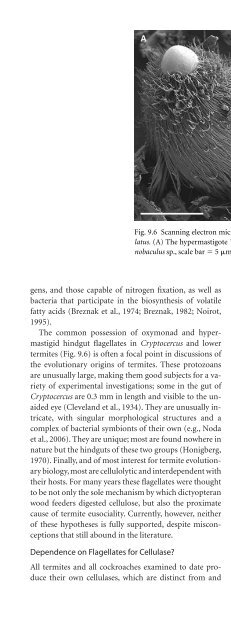Cockroache; Ecology, behavior & history - W.J. Bell
Cockroache; Ecology, behavior & history - W.J. Bell
Cockroache; Ecology, behavior & history - W.J. Bell
You also want an ePaper? Increase the reach of your titles
YUMPU automatically turns print PDFs into web optimized ePapers that Google loves.
Fig. 9.6 Scanning electron micrographs of flagellates from the hindgut of Cryptocercus punctulatus.<br />
(A) The hypermastigote Trichonympha sp., scale bar 25 m. (B) The oxymonad Saccinobaculus<br />
sp., scale bar 5 m. Images courtesy of Kevin J. Carpenter and Patrick J. Keeling.<br />
gens, and those capable of nitrogen fixation, as well as<br />
bacteria that participate in the biosynthesis of volatile<br />
fatty acids (Breznak et al., 1974; Breznak, 1982; Noirot,<br />
1995).<br />
The common possession of oxymonad and hypermastigid<br />
hindgut flagellates in Cryptocercus and lower<br />
termites (Fig. 9.6) is often a focal point in discussions of<br />
the evolutionary origins of termites. These protozoans<br />
are unusually large, making them good subjects for a variety<br />
of experimental investigations; some in the gut of<br />
Cryptocercus are 0.3 mm in length and visible to the unaided<br />
eye (Cleveland et al., 1934). They are unusually intricate,<br />
with singular morphological structures and a<br />
complex of bacterial symbionts of their own (e.g., Noda<br />
et al., 2006). They are unique; most are found nowhere in<br />
nature but the hindguts of these two groups (Honigberg,<br />
1970). Finally, and of most interest for termite evolutionary<br />
biology, most are cellulolytic and interdependent with<br />
their hosts. For many years these flagellates were thought<br />
to be not only the sole mechanism by which dictyopteran<br />
wood feeders digested cellulose, but also the proximate<br />
cause of termite eusociality. Currently, however, neither<br />
of these hypotheses is fully supported, despite misconceptions<br />
that still abound in the literature.<br />
Dependence on Flagellates for Cellulase?<br />
All termites and all cockroaches examined to date produce<br />
their own cellulases, which are distinct from and<br />
unrelated to those produced by the hindgut flagellates<br />
(Watanabe et al., 1998; Lo et al., 2000; Slaytor, 2000;<br />
Tokuda et al., 2004). The common possession of a certain<br />
family of cellulase genes (GHF9) in termites, cockroaches,<br />
and crayfish suggest that these enzymes were established<br />
in the Dictyopteran lineage long before flagellates<br />
took up permanent residence in the hindguts of an<br />
ancestor of the termite-Cryptocercus clade (references in<br />
Lo et al., 2003b). At present, Cryptocercus and lower termites<br />
are considered to have a dual composting system<br />
(Nakashima et al., 2002; Ohkuma, 2003); cellulose is degraded<br />
by the combined enzymes of the host and the<br />
hindgut flagellates. Nonetheless, these hosts are dependent<br />
on the staggeringly complex communities of mutually<br />
interdependent co-evolved organisms from the Archaea,<br />
Eubacteria, and Eucarya in their digestive systems.<br />
The interactions of the microbes with each other and<br />
with their hosts are still poorly understood; however, exciting<br />
inroads are being made by the laboratories actively<br />
studying them, and the field is advancing quickly (e.g.,<br />
Tokuda et al., 2004, 2005; Inoue et al., 2005; Watanabe et<br />
al., 2006). Products of cellulose degradation by gut protozoans<br />
may indirectly benefit the insect host by providing<br />
energy for anaerobic respiration and nitrogen fixation<br />
in gut bacteria (Bignell, 2000a; Slaytor, 2000). A comparison<br />
of gene expression profiles among castes of the termite<br />
Reticulitermes flavipes suggests that cellulases produced<br />
by the symbionts may be particularly important in<br />
TERMITES AS SOCIAL COCKROACHES 159


